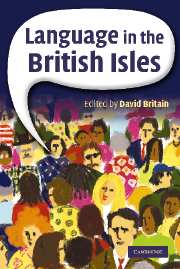Book contents
- Frontmatter
- Contents
- List of figures
- List of tables
- List of contributors
- Acknowledgements
- Map of the British Isles
- Introduction
- Part I English
- Part II The Celtic Languages
- Part III The Other Languages of the British Isles
- 15 Multilingualism
- 16 Caribbean creoles and Black English
- 17 Indic languages
- 18 Chinese
- 19 European immigrant languages
- 20 Sign languages
- 21 Channel Island French
- 22 Angloromani
- Part IV Applied Sociolinguistic Issues
- References
- Index
17 - Indic languages
Published online by Cambridge University Press: 16 January 2010
- Frontmatter
- Contents
- List of figures
- List of tables
- List of contributors
- Acknowledgements
- Map of the British Isles
- Introduction
- Part I English
- Part II The Celtic Languages
- Part III The Other Languages of the British Isles
- 15 Multilingualism
- 16 Caribbean creoles and Black English
- 17 Indic languages
- 18 Chinese
- 19 European immigrant languages
- 20 Sign languages
- 21 Channel Island French
- 22 Angloromani
- Part IV Applied Sociolinguistic Issues
- References
- Index
Summary
Introduction
At the beginning of the twenty-first century, Indic languages have established themselves as a very significant part of the linguistic mix of multicultural Britain. The number of Indic languages is, of course, great, but in the British context, there are five, with their varieties, that are most quantitatively significant: Bangla, Gujarati, Hindi, Panjabi and Urdu. The vast majority of South Asians in Britain speak one or another of these languages, which all belong to the Indo-Aryan branch of the Indo-European family of languages. Nonetheless, communities of speakers of other Indic languages must not be overlooked, in particular Tamil (a Dravidian language spoken in South India and Sri Lanka) and Pashto (one of the four main regional languages of Pakistan).
Background and history
Contact between Indic-language and English speakers has a long history, beginning with the arrival of the English in India at the end of the sixteenth century, continuing throughout the period of British colonialism in the Indian subcontinent, and since Independence through the migration of Indians, Pakistanis and Bangladeshis to Britain. Immigration, too, has a long history. There were Bangla migrations in the 1920s and 1930s, and Sikh peddlers were to be seen in many British cities (Agnihotri 1987:15–16, Mahandru 1991:117–18). But the major movements into Britain came in two waves: first in the 1950s and 1960s, from post-Independence India, West and East Pakistan (which later emerged as Bangladesh), and second in the late 1960s and 1970s from East Africa (Kenya and Uganda) when policies of Africanisation forced South Asians to uproot.
Information
- Type
- Chapter
- Information
- Language in the British Isles , pp. 293 - 307Publisher: Cambridge University PressPrint publication year: 2007
Accessibility standard: Unknown
- 3
- Cited by
